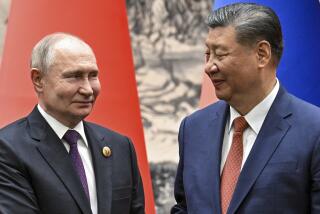U.S.-China Summit Stirs Winds of Pragmatism
All the pomp and ceremony of President Jiang Zemin’s state visit to Washington could not conceal the chill that still hangs over the Sino-American relationship. There was no historic result at the summit. But President Clinton and the Chinese leader did agree to work toward “a constructive, strategic partnership” between the two nations. A new level of cooperation is necessary and overdue, but still elusive.
The two men discussed many issues, seeking a multifaceted approach to a relationship that has stalled and sputtered for years now, primarily over the emotive issue of political and human rights in China. Meanwhile, economic ties have expanded, a “natural” across the Pacific. For Clinton and Jiang, the goal is to define the relationship within the realm of mutual interests while tolerating strains on divisive matters.
Illustrative of what can be done, the summit ended with a series of agreements on nuclear power and energy and military programs. Beijing added considerable spin toward better ties by signing a $3-billion aircraft order with the Boeing Co.
That’s the progress bulletin. On the downside remains the tough issue of human rights. In a chilly public exchange, Clinton challenged Jiang’s defense of China’s bloody handling of the 1989 Tiananmen Square demonstrations and its insistence on order and stability at the expense of individual expression.
“The continuing reluctance to tolerate political dissent,” Clinton said, has kept China from achieving “the level of support in the rest of the world that otherwise would have developed.” Clinton may have disappointed human rights advocates by failing to pursue some substantive measures but he stood forthright on principle.
Other differences remain. Among them is the U.S. insistence that China open its markets and make other economic changes before Washington will support Beijing’s entry into the World Trade Organization. This is business, something that can be closely measured, and U.S. negotiators properly held firm on demanding that China meet world standards.
Jiang’s visit will be compared to the late Deng Xiaoping’s memorable visit in 1979. Indeed, the itinerary was scripted to parallel Deng’s, right down to the same room for the state dinner. Jiang trekked to famous locales of American democracy. He recited the Gettysburg Address. He welcomed photo ops and ducked protesters, so the film sent back to China is likely to boost his image.
Make no mistake, the fledgling advances in U.S.-Sino cooperation are as delicate as a feather on a Pacific breeze. But the two leaders clearly are conscious of the implications should they succeed in fashioning a relationship for the 21st century. Next year’s summit in Beijing should provide a measure.
More to Read
Sign up for Essential California
The most important California stories and recommendations in your inbox every morning.
You may occasionally receive promotional content from the Los Angeles Times.










